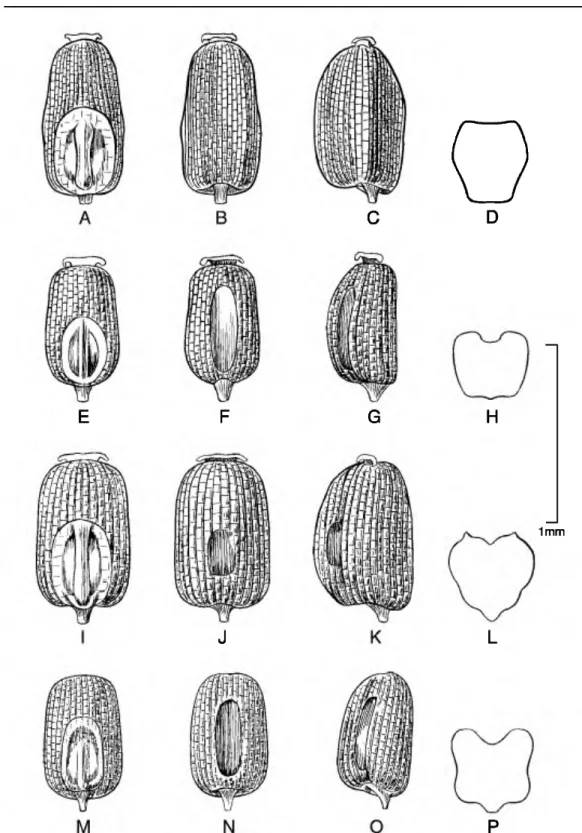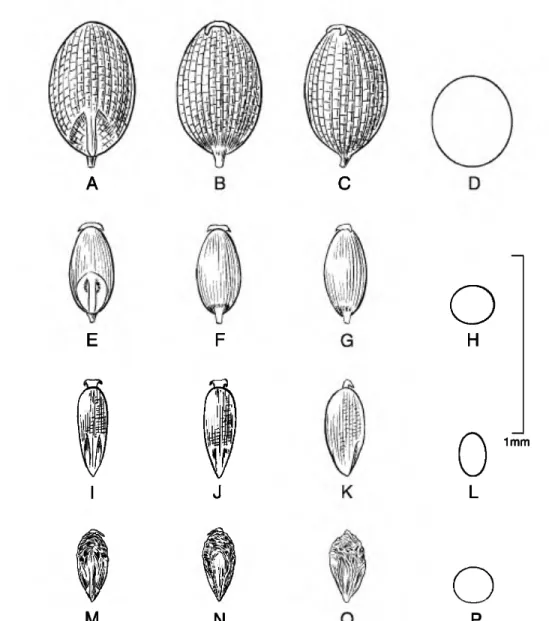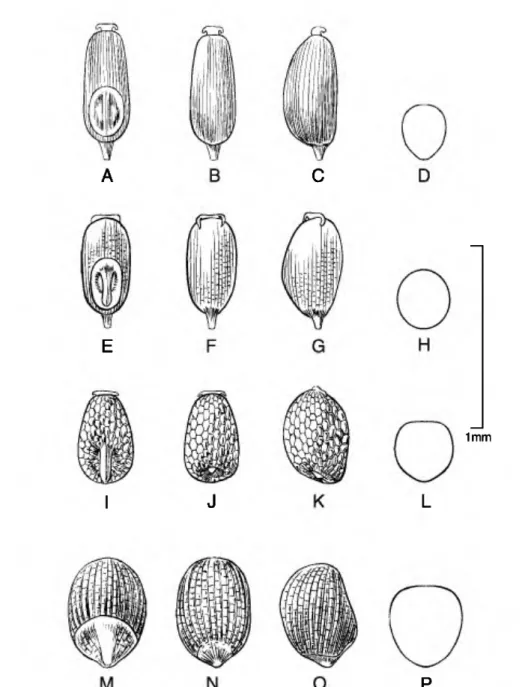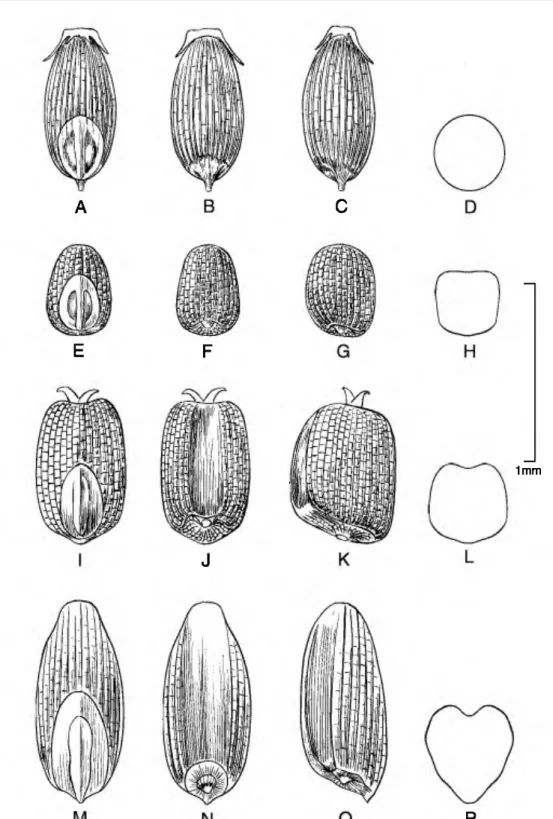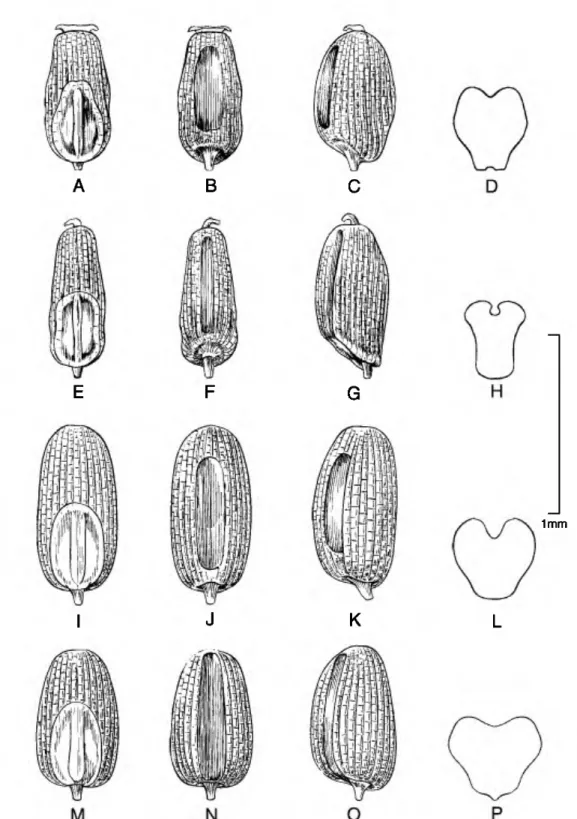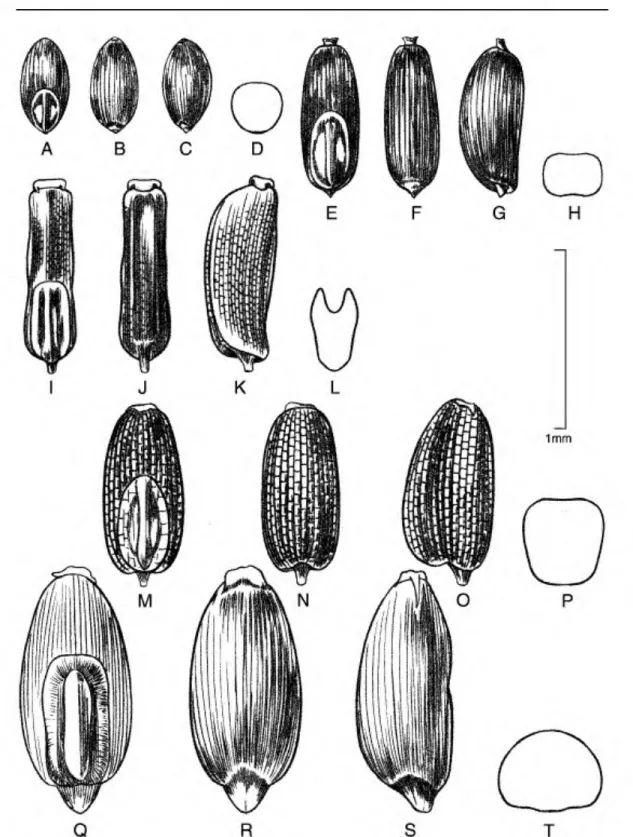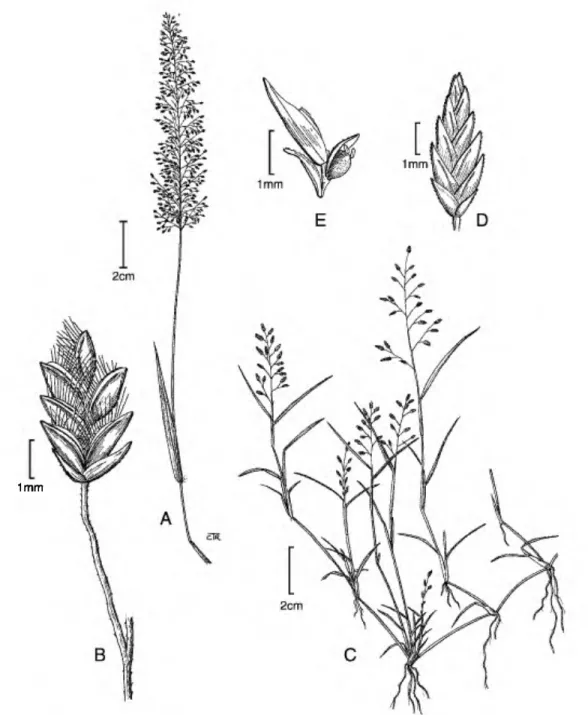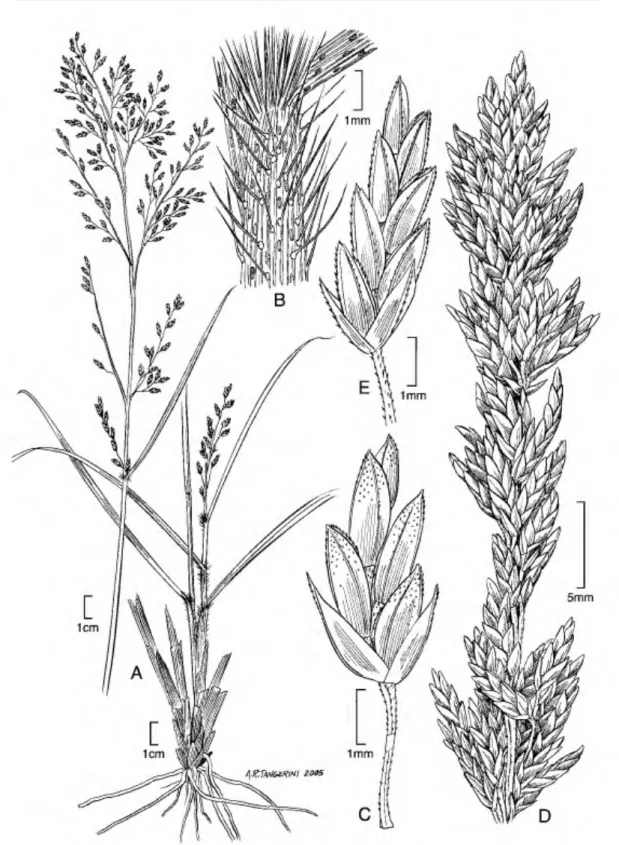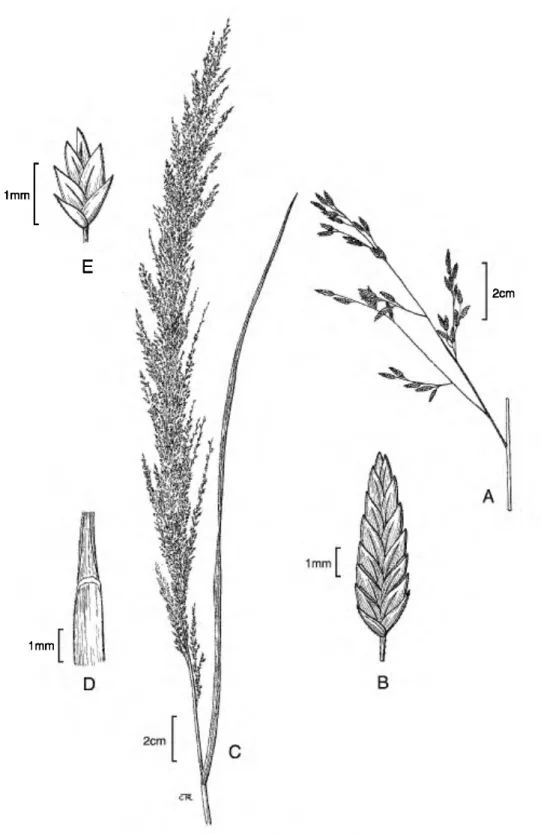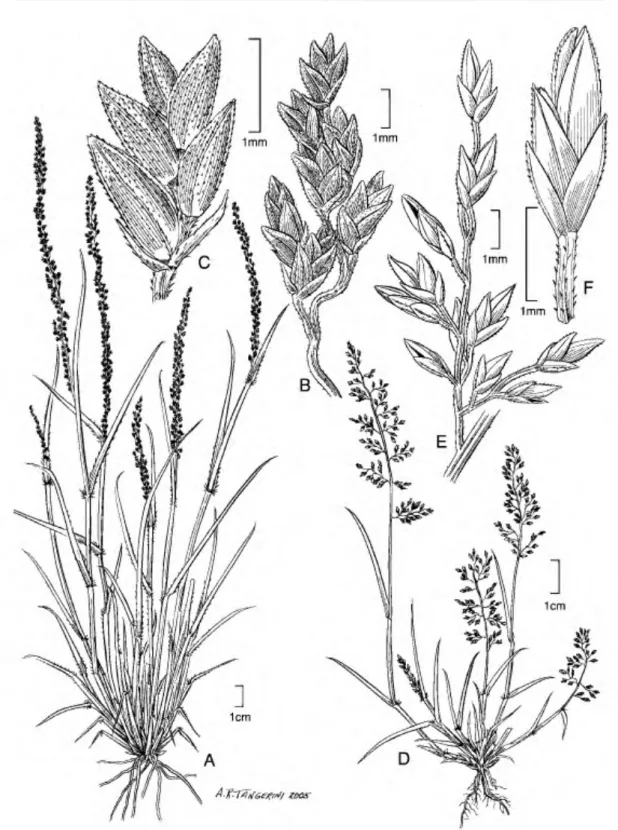ERAGROSTIS (POACEAE: Paul M. Peterson
2and hidoro Sanchez Vega"
CHLORIDOIDEAE:
ERAGROSTIDEAE:
ERAGROSTIDINAE) OF PERU
1ABSTRACT
A taxonomic treatment of Eragrostis Wolf for Peru is given. Twenty-three species and three subspecies of Eragrostis are recognized in the study area. Fifteen species of Eragrostis are native to Peru, and eight are adventive or introduced. Eragrostis attenuata Hitchc, E. pilgeri Fedde, and E. magna Hitchc. are endemic to Peru. Eragrostis lurida subsp. contraeta (Pilg.) P. M.
Peterson & Sanchez Vega, native to Ecuador and Peru, and E. pilgeri subsp. ancashensis (P. M. Peterson, Refulio & Tovar) P.
M. Peterson & Sanchez Vega, native to Peru, are new combinations. Keys for determining the species, descriptions, distributions, specimens studied, illustrations, synonymies, and a brief discussion of caryopsis morphology for all native and adventive species of Eragrostis in Peru are provided. The names E. andicola R. E. Fr., E. contraeta Pilg., E. tristis Jedwabn., and Poa mexicana Hornem. are lectotypified.
RESUMEN
Se presenta un estudio taxonomico de Eragrostis Wolf para Peru. Veintitres especies y tres subespecies de Eragrostis se reconocen en el area de estudio. Quince especies de Eragrostis son nativas de Peru y ocho son advenedizas o introducidos.
Eragrostis attenuata Hitchc, E. pilgeri Fedde y E. magna Hitchc. son endemicos de Peru. Eragrostis lurida subsp. contraeta (Pilg.) P. M. Peterson y Sanchez Vega native de Ecuador y Peru, y E. pilgeri subsp. ancashensis (P. M. Peterson, Refulio y Tovar) P. M. Peterson y Sanchez Vega native de Peru son combinaciones nuevas. Se incluyen claves para determinar las especies, descripciones, distribuciones, los especi'menes estudiados, las ilustraciones, las sinonimias, y una breve discusion de la morfologia de la cariopsis para todas las especies nativas y advenedizas de Eragrostis en Peru. Los nombres E. andicola R.
E. Fr., E. contraeta Pilg., E. tristis Jedwabn. y Poa mexicana Hornem. fueron lectotipificados.
Key words: Chloridoideae, Eragrostideae, Eragrostidinae, Eragrostis, Gramineae, Peru, Poaceae.
Peru is a tropical country located in the central and biodiversity associated with many different habitats, western part of South America between 0° and 18° The climate here is very warm and humid with high south latitude. The central Andes or backbone of Peru levels of precipitation, and there are great rivers like are important in the formation and delineation of three the Rio Maranon and the Rio Ucayali that feed into great regions: coast, mountain, and forest. The coastal the Rio Amazonas.
region next to the Pacific Ocean is an extremely xeric, The Poaceae are a diverse family that occupies narrow, sandy plain that rises abruptly to the east. a myriad of terrestrial habitats in Peru, with the This region is occasionally transected by river valleys, exception of the permanent snow fields. The taxo- and the climate is very mild and warm. The mountain nomic knowledge of this family in Peru is incomplete, region or "cordillera de Andes" consists of high peaks and it is still possible to encounter novel species, and extensive high plains (altiplano) that are Hitchcock (1927), in his treatment of the grasses of sometimes dissected by deep, narrow valleys. The Ecuador, Peru, and Bolivia, recognized 27 species of climate in this region can be very cold, and it is not Eragrostis Wolf, 16 of these being reported in Peru, uncommon to have snow above 3800 m. The tropical Standley (1936), in his Flora of Peru, recorded 19 forest region east of the cordillera extends into the species. More recently, Tovar (1993) produced an Amazonian river basin where there are high levels of integral study of the Peruvian grasses, including 21
1 We wish to thank the curators at the following herbaria for help locating specimens: AMAZ, CPUN, CUZ, HAO, HUT, US, and USM; the Smithsonian Institution Fellowships and Grants for supporting a research visit by ISV to the United States National Herbarium; Research Opportunities, Atherton Seidell Foundation, Jose Cuatrecasas Fund, and Biodiversity Surveys and Inventories Program all at the Smithsonian Institution for financial support; Utah State University for permission to use illustrations that appeared in Flora of North America, Volume 25, prepared by Linda A. Vorobik and Cindy Roche; Alice R.
Tangerini for preparing illustrations and for preparing all the plates; and Tom Cope and Victoria Hollowed for reviewing the manuscript.
2 Department of Botany, National Musuem of Natural History, Smithsonian Institution, Washington, DC 20013-7012, U.S.A.
3 Departamento de Biologia, Herbario CPUN, Universidad Nacional de Cajamarea, Apartado 55, Cajamarca, Peru.
ANN. MISSOURI BOT. GARD. 94: 745-790. PUBLISHED ON 13 DECEMBER 2007.
species of Eragrostis. Brako and Zarucchi (1993) list 29 species as being present in Peru; however, many of these are not verified or are synonyms of names in current use. All of these treatments are out of date, and there have been many new reports of grasses from Peru. Because Eragrostis is a large genus and is easily dispersed, a modern investigation was undertaken to more clearly understand its biogeography and sys- tematics. We report 23 species and three subspecies of Eragrostis in Peru. Two of the subspecies are new combinations.
Eragrostis is a large genus of approximately 350 species occurring in tropical, subtropical, and warm temperate regions throughout the world (Clayton &
Renvoize, 1986; Watson & Dallwitz, 1992; Peterson et al., 1995, 1997, 2001). There are 111 species of Eragrostis recorded in North, Central, and South America, 67 native in South America (Peterson et al., 2001, 2007; Peterson, 2003). The genus is character- ized by having many-flowered spikelets where the disarticulation of the lemma and palea occurs separately, lemmas that are usually 3-nerved and unawned, longitudinally bowed-out paleae with cilio- late keels, paniculate inflorescences, and leaves with ciliate ligules (Peterson et al., 1997). Most species of Eragrostis occupy open habitats with poor soils, and many occur in disturbed localities (Clayton &
Renvoize, 1986; Van den Borre & Watson, 1994).
All species of Eragrostis that have been examined anatomically exhibit "Kranz" or C4 leaf anatomy (except E, walteri Pilg. from South Africa, which exhibits C:1 leaf anatomy; see Ellis, 1984), and species have either chloridoid bicellular microhairs (with the broad, short terminal cell the same thickness as the basal cell) or panicoid bicellular microhairs (with a long, thin-walled terminal cell) (Amarasinghe &
Watson, 1990). Apparently, three C4 biochemical types exist in Eragrostis: NAD-ME (nicotinamide adenine dinucleotide co-factor malic enzyme), PCK (phosphoenolpyruvate carboxykinase), and intermedi- ates (Prendergast et al., 1986).
The classification of the tribe Eragrostideae has been problematic, primarily because no one has been able to define this group and select diagnostic characters that exclusively delimit this tribe from other tribes in the Chloridoideae (Hilu & Alice, 2000, 2001; Van den Borre & Watson, 1997, 2000). Historic accounts of the ever-changing opinions of systematists on the classification of the Eragrostideae can be found in Peterson et al. (1995) and Van den Borre and Watson (1994). Peterson et al. (1997) recognized 38 Eragrostideae genera occurring in the New World, then later placed many of these same genera in the tribe Cynodonteae without delineating an Eragrosti- deae (Peterson et al., 2001). Based on results of a DNA
sequence study of the Chloridoideae (Columbus et al., 2007), Peterson et al. (2007) has proposed a com- pletely new classification of the New World Chlor- idoideae. Here, the Eragrostideae are narrowly interpreted to include only three small subtribes (Cotteneinae, Uniolinae, and Eragrostidinae) that diverge as a clade at the base of the chloridoids (Peterson et al., 2007). Character trends in the Eragrostideae include spikelets with many florets, lemmas with 3 to 13 nerves, and many species adapted to xeric habitats.
The subtribe Eragrostidinae as treated here in- cludes three genera: Cladoraphis cyperoides (Thunb.) S. M. Phillips, introduced from Africa; Eragrostis with 112 species (86 native New World spp.); and Steirachne Ekman with two species (Peterson, 2003;
Peterson et al., 2007). The Eragrostidinae are characterized by having hairy or glabrous culm nodes;
hairy or glabrous rachillas; entire lemma apices that are awnless, mucronate, or short-awned (only in the latter two genera); glabrous or scabrous lemmas that are (l)3(5)-nerved; and short basal microhair cells (15-75 |J.m) on the abaxial epidermis of the leaf blade.
Recent systematic treatments of Eragrostis from Argentina (Nicora, 1998), Australia (Lazarides, 1997), Bolivia (Renvoize, 1998), Brazil (Boechat & Longhi- Wagner, 2000, 2001), Ecuador (Laegaard & Laegaard
& Peterson, 2001), Guianas (Judziewicz, 1991), Malesia (Veldkamp, 2002), Mesoamerica (Davidse, 1994), Mexico (Beetle et al., 1991; Peterson & Valdes Reyna, 2005), the United States and Canada (Peter- son, 2003), and Zambesiaca (Cope, 1998) have given us a good understanding of the species limits and their distribution. Based on nuclear and plastid DNA sequences, Ingram and Doyle (2003, 2004, 2007) tested the monophyly of Eragrostis and found that, with the inclusion of Acamptoclados Nash (E.
sessilispica Buckley), Diandrochloa De Winter, Neer- agrostis Bush, and Pogonarthria Stapf, the genus is indeed monophyletic. However, only 37 species of Eragrostis were included in their analysis, so any infrageneric interpretations were beyond the scope of their work. What is lacking is a definitive treatment of the infrageneric classification of the entire genus.
Based on spikelet disarticulation, Clayton (1974) and Clayton and Renvoize (1986) have arrived at a first approximation to natural groups and have presented a key to sections Psilantha (K. Koch) Tzvelev, Eragrostis, Lappula Stapf, and Platystachya Benth.
In most native New World species, the lemmas fall acropetally (from the base toward the apex) from the persistent rachilla, with the paleae persistent on the rachilla. The other major pattern of spikelet disartic- ulation in Eragrostis is when the lemmas fall basipetally (from the apex toward the base). Van den
Volume 94, Number 4 2007
Peterson & Sanchez Vega Eragrostis of Peru
747
Borre and Watson (1994) investigated 53 species of Eragrostis and found that anatomical characters, among others, support the recognition of two distinct groups: subgenus Eragrostis and subgenus Caesiae Van den Borre & L. Watson. The most comprehensive attempt so far is Lazarides' (1997) treatment of the Australian Eragrostis, in which he recognized six groups primarily based on spikelet disarticulation.
Lazarides (1997) correlates his classification with Van den Borre and Watson (1994), who recognized subgenus Eragrostis and subgenus Psilantha, and with Amarasinghe and Watson (1990), who investi- gated microhair morphology within the genus. Cope's (1998) informal treatment of Eragrostis for the flora of Zambesiaca is also comprehensive since he delineates nine species groups based on panicle, lemma, and palea morphology in addition to spikelet disarticula- tion. Based on caryopsis morphology, Boechat and Longhi-Wagner (2003) placed 49 of the 53 species of Eragrostis that occur in Brazil into the following six groups: smooth-walled (six species), medianly re- ticulate (14 species), roughly reticulate (10 species), finely reticulate (nine species), alveolate (six species), and striate (four species). Overall morphological features led Peterson and V aides Reyna (2005) to recognize the following four hypothesized lineages within 26 species of Eragrostis from northeastern Mexico: an Old World group, the E. intermedia Hitchc. complex, the E. pectinacea complex, and the E. spectabilis (Pursh) Steud.•E. secundiflora J. Presl group.
Our taxonomic treatment contains a key for determining species, descriptions, distribution, speci- mens studied, illustrations, synonymies, and a brief discussion of caryopsis morphology and its usefulness in hypothesizing relationships among the native and adventive species of Eragrostis in Peru. This study is based on the examination of herbarium specimens from AMAZ, CPUN, CUZ, HAO, HUT, US, and USM, including the type specimens of most of the species studied.
TAXONOMIC TREATMENT
Eragrostis Wolf, Gen. PI. 23. 1776. TYPE: Eragrostis minor Host, Icon. Descr. Gram. Austriac. 4: 15.
1809 (lectotype, designated by Ross, Acta Bot.
Neerl. 15: 157. 1966).
Plants annual or perennial; usually synoecious, sometimes dioecious; caespitose, stoloniferous, or rhizomatous; flowering culms (2-)5-150 cm tall, not woody, erect, decumbent, or geniculate, sometimes rooting at the lower nodes, simple or branched;
internodes solid or hollow; bud initiation intravaginal, rarely extravaginal. Leaf sheaths open, often with tufts
of hairs at the apices, hairs 0.3•9 mm; ligules usually membranous and ciliolate or ciliate, cilia sometimes longer than the membranous base, occasionally of hairs or membranous and non-ciliate; blades flat, folded, or involute. Inflorescences terminal, some- times also axillary, simple panicles, open to con- tracted or spike-like, terminal panicles usually exceeding the upper leaves; pulvini in the axils of the primary branches glabrous or hairy; branches not spike-like, not disarticulating. Spikelets 1-20 X 0.5- 4.5 mm, laterally compressed, with 2 to 40 florets;
disarticulation below the fertile florets, sometimes also below the glumes, acropetal with deciduous glumes and lemmas but persistent paleae, or basip- etally with the glumes often persistent and the florets usually falling intact; glumes usually shorter than the adjacent lemmas, (l)3(5)-veined, not lobed, apices obtuse to acute, unawned; calluses glabrous or sparsely pubescent; lemmas usually glabrous, obtuse to acute, 3(5)-veined, usually keeled, unawned or mucronate; paleae shorter than the lemmas, longitudi- nally bowed-out by the caryopses, 2-keeled, keels usually short or long ciliate, intercostal region mem- branous or hyaline; anthers 2 or 3; ovaries glabrous;
styles free to the bases. Cleistogamous spikelets occasionally present, sometimes on the axillary pani- cles, sometimes on the terminal panicles. Caryopses variously shaped; hilum short; embryo with an epiblast, scutellar tail, and elongated mesocotyl internode (formula P + PF), endosperm hard. Base chromosome number, x = 10 (Watson & Dallwitz, 2003).
Comments. In most taxa native to the Western Hemisphere, disarticulation of the spikelet is acrop- etal (florets first maturing at the base) and the lemmas fall with the caryopses, leaving paleae attached to the rachilla. The common mode of disarticulation for introduced species from Africa and Asia is basipetal- ly, where the florets near the apex mature first.
Etymology. The origin of the name is somewhat obscure. Nathaniel von Wolf (1776), who first named Eragrostis, made no statement concerning the origin of its name. Clifford (1996) provides three possible derivations: from "eros" (love) and "Agrostis" (the Greek name for an indeterminate herb); from the Greek "er" (early) and "agrostis" (wild), referring to the fact that some species of Eragrostis are early invaders of arable land; or the Greek "eri-" (a prefix meaning "very" or "much"), suggesting that the name means many-flowered "Agrostis." Watson and Dall- witz (2005) indicate that the derivation of Eragrostis is
"from the Greek 'eros' (love) or 'era' (earth) and 'agrostis' (a grass), probably alluding to the charac- teristic, earthy (human) female aroma of the inflo- rescences of many species."
Ecology and geographic distribution. The 23 species of Eragrostis in Peru are widely distributed among the coast, mountain, and forest regions. The annual species are more conspicuous along the sandy plain of the coast, the interior valleys of the western slopes, and in the dry Andean valleys at lower elevations. Along the north coast, E. tenella (L.) P.
Beauv. ex Roem. & Schult., E. ciliaris (L.) R. Br., and E. cilianensis (All.) Vignolo ex Janch. form part of the xerophytic vegetation that flowers between January and March. The lomas vegetation to the south of 8°
south latitude contains E. attenuata Hitchc, E.
peruviana (Jacq.) Trim, and E. weberbaueri Pilg. and generally flowers between June and October. In the mountains, species of Eragrostis are an integral component of natural, high-elevation ecosystems.
Eragrostis nigricans (Kunth) Steud. and E, pilosa (L.) P. Beauv. are usually found growing along margins of cultivated fields, while many other species inhabit edges of roads and trails. Eragrostis lurida J.
Presl, E, magna Hitchc, E. pastoensis (Kunth) Trim, E. pilgeri Fedde, and E. weberbaueri are principally found in the altiplano and puna of southern Peru, and disappear in the jalca or paramo in the north. In this mountainous region of central and southern Peru, there is a greater number of perennial, native species of Eragrostis. Eragrostis hypnoides (Lam.) Britton, Sterns & Poggenb. is the only species commonly found along the coast and in the Amazonian forest in areas that are periodically flooded (i.e., margins of rivers).
Caryopsis morphology. The caryopsis contains many morphological features that are important aids in the identification of species, and this information can be used to infer hypothetical relationships among the grasses (Colbry, 1957; Terrell & Peterson, 1993;
Boechat & Longhi-Wagner, 2003). In Eragrostis, grains can be terete, subterete, or rectangular or trigonous in cross section and are sometimes com- pressed either dorsally (on a plane with the emryo) or laterally (Figs. 1-6). The shape of the grain can vary from spherical to much longer than broad (ellipsoid, obovoid, ovoid, rectangular-prismatic, etc.). The embryo is located on the dorsal (abaxial) surface of
the grain, and the hilum is the tiny scar left from the attachment of the funiculus found near the base on the ventral surface. The ventral (adaxial) surface can be rounded, flattened, or sometimes have a sulcus or groove running longitudinally along the body. The surface of the grain can be smooth to variously sculptured and is often striate to reticulate. In the grasses, the surface or pericarp of the grain is almost always adnate, i.e., a true caryopsis; however, a few species of Eragrostis (see E. japonica (Thunb.) Trin.) can have loose pericarps that shed when the grain is moistened. The color of the grain can vary in the Peruvian Eragrostis from light brownish or whitish to reddish brown, and the grains can be translucent to opaque.
The most common caryopsis type found in Peruvian Eragrostis is the rectangular-prismatic to irregularly triangular, laterally flattened, striate, reticulate- walled, and ventrally grooved grain. This is found predominately in species that occupy the altiplano such as E. lurida, E. magna, E. pastoensis, and E.
pilgeri, as well as in E. andicola R. E. Fr., E. lugens Nees, E. soratensis, E. mexicana (Hornem.) Link, E.
nigricans, and E. tenuifolia (A. Rich.) Hochst. ex Steud. (of African origins). Eragrostis pectinacea (Michx.) Nees and E. pilosa are similar to the last group, although these two species have grains that are striate only and rectangular in cross section, so they are at least flattened ventrally but do not have a groove. Eragrostis maypurensis (Kunth) Steud. is unique in possessing rhomboid reticulations without striations. Eragrostis tenella, E. atrovirens (Desf.) Trin.
ex Steud., E. attenuata, E. cilianensis, E. ciliaris, E.
curvula (Schrad.) Nees, E. hypnoides, E. japonica, E.
maypurensis, E. peruviana, and E. weberbaueri are all circular or elliptical to ovate/obovate in cross section.
Eragrostis tenella, E. attenuata, E. ciliaris, E. curvula, and E. japonica are striate or smooth with no evidence of reticulations. Eragrostis ciliaris, E. japonica, E.
pilosa, and E. curvula all have somewhat dorsally flattened caryopses. Eragrostis curvula, in addition to being strongly dorsally flattened, can sometimes possess a shallow and broad ventral groove.
KEY TO THE SPECIES OF ERAGROSTIS IN PERU
la. Annuals, caespitose, stoloniferous or mat-forming to geniculate, without innovations at the basal nodes.
2a. Palea keels prominently ciliate, the cilia 0.2-0.8 mm long.
3a. Panicles 1-7 cm wide, open, narrowly ovate; primary branches ascending and spreading 20°-100° from the rachises; spikelets (1•)1.5•2.2 mm long 1. E. tenella 3b. Panicles 0.2•1.5(•3) cm wide, cylindrical, spiciform and/or spike-like; primary branches ascending and
tightly appressed; spikelets 1.8-4.5 mm long.
4a. Spikelets 1.8-3.2 mm long; cilia on the palea stiff and pectinate-thickened near base; stamens 2 6. E. ciliaris 4b. Spikelets 3^.5 mm long; cilia on the palea soft and silky, not pectinate-thickened near base;
stamens 3 18. E. peruviana
Volume 94, Number 4 Peterson & Sanchez Vega 749 2007 Eragrostis of Peru
2b. Palea keels smooth or scabrous, the scabridities less than 0.2 mm long.
5a. Plants extensively stoloniferous and mat-forming; panicles 1-3.5 cm long, terminal and axillary;
culms (2-)5-12(-20) cm tall 8. E. hypnoides 5b. Plants not stoloniferous but occasionally mat-forming; panicles (3•)4-^10 cm long; culms 8-130 cm
tall.
6a. Ligules membranous, glabrous 9. E. japonica 6b. Ligules membranous and ciliate, with a row of tiny white hairs.
7a. Crateriform glands present on the keels of the lemma, these glands usually present on the keels of the glumes, margins of the blades, sheaths, and below the nodes of the culm
5. E. cilianemis 7b. Crateriform glands not present on the keels of the lemma, keels of the glumes, and margins
of the blades, occasionally present below the nodes of the culm and sheaths.
8a. Caryopses with a shallow or deep ventral groove.
9a. Spikelets not arranged in glomerules, 5- to ll(to 15)-flowered, (4•)5•10(-11) mm long; pedicels appressed to narrowly divergent, stiff 14. E. mexicana 9b. Spikelets arranged in glomerules, 2- to 4(to 5)-flowered, 2.6•3.8 mm long;
pedicels spreading, divaricate and stout 15. E. nigricans 8b. Caryopses without a ventral groove.
10a. Lower glumes 2-2.6 mm long, usually longer than upper; pedicels 0•1.5 mm long, shorter than the spikelets; lemmas chartaceous, lateral nerves and midnerve evident, usually green; stamens 2; caryopses obovate to circular in cross section 13. E. maypurensis 10b. Lower glumes 0.3•1.5 mm long, shorter than the upper; pedicels 0.8-10 mm
long, longer or shorter than the spikelets; lemmas hyaline to membranous, lateral nerves and midnerve inconspicuous to moderately conspicuous, never green; stamens 3; caryopses rectangular in cross section.
11a. Lower glumes 0.5-1.5 mm long, at least 1/2 as long as the lowest lemmas;
paleae persistent; spikelets 1.2-2.5 mm wide; panicle branches solitary or paired at the lowest two nodes; lemmas with moderately conspicuous lateral nerves 17. E. pectinacea lib. Lower glumes 0.3-0.6(-0.8) mm long, usually less than 1/2 as long as the
lowest lemmas; paleae easily deciduous; panicle branches usually whorled at the lowest two nodes; lemma with inconspicuous lateral nerves 20. E. pilosa lb. Plants perennial or biennial, caespitose, forming innovations at the basal nodes.
12a. Panicles 0.2-2 cm wide, contracted, densely flowered, cylindrical and narrowly spicate to spiciform, the primary branches ascending and tightly appressed.
13a. Panicle rachis densely pilose, the hairs not rigid; culm nodes silky pilose, the hairs up to 3 mm long;
blades densely silky pilose above and below 23. E. weberbaueri 13b. Panicle rachis glabrous; culm nodes glabrous or occasionally with a tuft of hairs, the hairs less than
1 mm long; blades glabrous, scabrous, with a few scattered hairs or short pilose but not densely silky.
14a. Panicles 2-5 mm wide; lower glumes 0.8-1 mm long; lemma apex obtuse; caryopses only striate, elliptical in cross section and without a ventral groove; anthers about 0.3 mm long ... 4. E. attenuata 14b. Panicles 5-20 mm wide; lower glumes 1-1.5 mm long; lemma apex acute; caryopses striate and
reticulate, rectangular in cross section and usually with a ventral groove or at least flattened ventrally; anthers 0.3•0.6 mm long.
15a. Secondary panicle branches condensed into tightly glomerate lobes of spikelets; pedicels 0.1•1 mm long, scabrous; lemma with conspicuous lateral nerves, lemma 1.6•2.4 mm long;
blades scaberulous above without additional hairs lib. E. lurida subsp. contracta 15b. Secondary panicle branches composed of loosely overlapping spikelets; pedicels 0.5-5 mm
long; lemma with inconspicuous lateral nerves, lemma 1.2-2.1 mm long; blades scaberulous above, sometimes with scattered hairs up to 4 mm long 16. E. pastoensis 12b. Panicles 2-27 cm wide, open, not contracted, the primary branches ascending and spreading to divaricate.
16a. Lemmas 2-3.2 mm long; upper glumes (1.8•)2•3 mm long.
17a. Anthers 0.4-0.7(•0.8) mm long; paleae 1.2•2.4 mm long.
18a. Secondary panicle branches composed of loosely overlapping spikelets; blades with scattered small oblong glands located above the veins; sheaths with papillose-based hairs;
pedicels 1.8-5 mm long, divaricate at maturity with a single glandular band near the middle 2. E. andicola 18b. Secondary panicle branches; blades without small oblong glands located above the veins;
sheaths without papillose-based hairs; pedicels 0.1•1 mm, ascending and appressed, without any glandular bands 11. E. lurida 17b. Anthers 0.8•2 mm; paleae 2•3.1 mm.
19a. Spikelets 1.2•2 mm; caryopses dorsally flattened, smooth to striate, elliptical in cross section, ventral surface with a shallow, broad groove or ungrooved I.E. curvula 19b. Spikelets 2-4.5 mm wide; caryopses laterally flattened to rectangular-prismatic,
rectangular to triangular in cross section, with a deep ventral groove.
20a. Culms 80•150 cm tall, with short rhizomes near base; spikelets 2•2.4 mm wide;
raehillas hairy only near apex, the hairs less than 0.2 mm long; blades 26-60 em long, 3-7 mm wide 12. E. magna 20b. Culms 26•84 cm tall, without rhizomes; spikelets (2•)2.2-4.5 mm wide; raehillas
hairy along entire length, the hairs 0.4-1.8 mm long; blades (6•)10-22(-26) em long, 1-2.5(•3) mm wide 19. E. pilgeri 16b. Lemmas 1.2•2(•2.1) mm long; upper glumes 0.5-2 mm long.
21a. Spikelets 6•12(•19) mm long, 6- to 22-flowered.
22a. Culms (70•)75•130 em tall; lower glumes 1.2•1.4 mm long; upper glumes 1.4-1.7 mm long; caryopses circular in cross section and not laterally flattened and without a ventral groove; anthers 0.7•0.9 mm long 3. E. atrovirens 22b. Culms 25-75 em tall; lower glumes 0.3•0.6 mm long; upper glumes 0.5•1 mm long;
caryopses narrowly triangular in cross section, strongly laterally flattened with a deep ventral groove; anthers 0.2•0.4 mm long 22. E. tenuifolia 21b. Spikelets 2•6 mm long, 2- to 10-flowered.
23a. Panicles 0.5-5(-7) cm wide, narrowly ovate, the primary branches floriferous near base;
secondary branches condensed into tightly glomerate lobes of spikelets; pedicels 0.1-1 mm long, ascending and appressed; lemmas with conspicuous lateral nerves 11. E. lurida 23b. Panicles 2-27 cm wide, open, ovate, the primary branches not floriferous near base;
secondary branches composed of loosely overlapping spikelets; pedicels 0.5-6(-7) mm long, appressed to spreading; lemmas with inconspicuous lateral nerves.
24a. Spikelets 0.5•1.1 mm wide; lower glumes 0.6-1 mm long; blades l-2(•2.2) mm wide, involute, rarely flat 10. E. lugens 24b. Spikelets 1•1.8 mm wide; lower glumes 1•1.4 mm long; blades l-4(•7) mm wide, flat
or involute.
25a. Culms 30-90 cm tall; blades 5-40(-45) em long; pedicels mostly appressed;
sheaths 3/4 as long as the internodes above 16. E. pastoensis 25b. Culms 10-40 em tall; blades 4•10 em long; pedicels spreading; sheaths longer
than the internodes above 21. E. soratensis
1. Eragrostis tenella (L.) P. Beauv. ex Roem. &
Schult., Syst. Veg. 2: 576. 1817. Basionym: Poa tenella L., Sp. PI. 1: 69. 1753. Megastachya tenella (L.) Bojer, Hortus Maurit. 369. 1837. TYPE: India.
(lectotype, designated by Veldkamp, Blumea 47:
164. 2002, Herb. Linn. 87.33-LINN!; IDC micro- fiche US!). Figures 6A-D; 7A, B.
Poa amabilis L., Sp. PI. 68. 1753. Eragrostis amabilis (L.) Wight & Arn., Bot. Beechey Voy. 251. 1838, hom.
illeg. Megastachya amabilis (L.) P. Beauv., Ess.
Agrostogr. 74, 167, 173. 1812. Cynodon amabilis (L.) Raspail, Ann. Sci. Nat., Bot. 5: 302. 1825. TYPE: Sri Lanka. Herb. Hermann 2: 59, no. 46 (lectotype, designated by Veldkamp in Cafferty et al., Taxon 49(2): 254. 2000, BM!; IDC microfiche US!).
Poa plamosa Retz., Observ. Bot. 4: 20. 1786. Eragrostis plumosa (Retz.) Link, Hort. Berol. 1: 192. 1827.
Eragrostis tenella var. plumosa (Retz.) Stapf, Fl.
Brit. India 7(22): 315. 1897 (1896). Eragrostis amabilis var. plumosa (Retz.) E. G. Camus & A. Camus, Fl.
Indo-Chine 7: 557. 1923. TYPE: India. E. Tranque- baria, Konig s.n. (holotype, LD not seen; isotype, K [fragm.]!).
Eragrostis ciliaris var. patens Chapm. ex Beal, Grasses N.
Amer. 2: 479. 1896. TYPE: U.S.A. Georgia: Wayne Co., Doctortown & Jesup, Sep.-Oct. 1880, A. H. Curtiss 3493 (holotype, MSC not seen; isotypes, NY!, US 748296!, US 821866!, US 909340!).
Annual, caespitose; culms 5-40(-50) cm tall, erect to spreading, mostly glabrous and occasionally with
oblong-glandular areas below the nodes. Leaf sheaths 1/2 as long as the internodes, ciliate at the summit, collar, and along margins of the upper portion, the hairs to 4 mm long, stiff; ligules 0.2•0.3 mm, ciliate;
blades 2-8 X 0.2-0.4 cm, flat to involute, glabrous below and scaberulous above, occasionally with a few scattered papillose-based hairs below. Panicles 4-15 X 1•7 cm, open, narrowly ovate, primary branches 0.5-4 cm, sometimes with irregular glandular areas below the branch bases, branches diverging 20°•
100° from the rachises; pulvini ciliate or glabrous;
pedicels 0.8-4(-7) mm, mostly pendent, drooping to erect. Spikelets (1-)1.5-2.2 X 0.9-1.2 mm, 4- to 8- flowered, ovate to oblong, reddish purple to greenish;
disarticulation between the florets with a portion of the rachilla; glumes 0.4-1.1 mm, unequal, ovate, hyaline, keeled, the nerve commonly green, scaber- ulous along the keel; lower glume 0.4•0.7 mm; upper glume 0.7•1.1 mm; lemmas 0.7•1.1 mm, ovate to broadly oblong, membranous, lateral nerves evident, usually greenish, strongly keeled, scaberulous along keel; apex truncate to obtuse; paleae 0.6-1.1 mm, hyaline, keels ciliate, the cilia 0.3-0.5 mm; apex obtuse to truncate; stamens 3, anthers ca. 0.2 mm, purplish. Caryopses 0.3-0.5 mm, ellipsoid, faintly striate, elliptical to circular in cross section, trans- lucent, light brown. In = 20 (Baquar & Saeed, 1969).
Volume 94, Number 4 2007
Peterson & Sanchez Vega Eragrostis of Peru
751
D
H
1mm
Figure 1. Caryopses of Eragrostis species. •A•D. E. lurida subsp. lurida (P. M. Peterson & N. F. Refulio-Rodriguez 13993). •E-H. E. pastoensis (P. M. Peterson & N. F. Refulio-Rodriguez 13982). •I-L. E. lugens (I. Sanchez Vega 3218).
•M-P. E. nigricans (M. 0. Dillon, U. Molau & P. Matekaitis 3258). Dorsal views (A, E, I, M); ventral views (B, F, J, N);
lateral views (C, G, K, 0); cross sections (D, H, L, P).
o H
1mm
Figure 2. Caryopses of Eragrostis species. •A-D. E. cilianensis (R. Ferreyra 6017). •E-H. E. ciliaris (A. Sagdstegui A.
10927). •I-L. E. hypnoides (A. Lopez M. & A. Sagdstegui A. 4023). •M-P. E. japonica (E. Asplund 14802). Dorsal views (A, E, I, M); ventral views (B, F, J, N); lateral views (C, G, K, 0); cross sections (D, H, L, P).
Distribution and habitat. Native in India; in- troduced in U.S.A., Mexico, Central America, Carib- bean, Brazil, Bolivia, Colombia, Ecuador, Guianas, Paraguay, Peru, and Venezuela (Nicora, 1998;
Peterson & Boechat, 2001); occurs in open areas near cultivated fields, dry forests, and along roadsides only in northwestern Peru; 0•1500 m.
Phenology. Flowering October through May.
Specimens examined. PERU. Amazonas: Prov. Bagua, Chiriaco-Nazareth, F. Holle 20575 (USM). Cajamarca:
Prov. Jaen, 1 km N of Chamayo on Hwy. 5N toward Jaen, P.
M. Peterson & N. F. Refulio-Rodriguez 15056 (US, USM);
6 km W of Hwy. 5N up Rio Tabaconas toward Tamborillo, P.
M. Peterson & N. F. Refulio-Rodriguez 15087 (US, USM).
Lambayeque: Prov. Lambayeque, betw. Chochope & La Ramada, J. T. Columbus, J. M. Porter & E. H. Roalson 3442 (RSA, US); Prov. Lambayeque, El Porvenir (Olmos), S. Llatas Q. 1180 (US). Piura: Prov. Piura, 15 km entre Piura y Sullana, /. Sanchez Vega & J. Guevara 6191 (CPUN, US).
Tumbes: Prov. Contralmirante Villar, SE de Zorritos, R.
Ferreyra 12268 (US).
2. Eragrostis andicola R. E. Fr., Nova Acta Regiae Soc. Sci. Upsal., ser. 4, 1(1): 180. 1905.
TYPE: Argentina. Prov. Jujuy: Moreno, "in
Volume 94, Number 4 2007
Peterson & Sanchez Vega Eragrostis of Peru
753
1mm
Figure 3. Caryopses of Eragrostis species. •A•D. E. attenuata {R. Eerreyra 6366). •E•H. E. weberbaueri (J. T.
Columbus, J. M. Porter & E. H. Roalson 3523). •I•L. E. maypwensis (C. M. Belshaw 3359). •M•P. E. peruviana (M. 0.
Dillon, P. Matekaitis & L. Watanabe 3342). Dorsal views (A, E, I, M); ventral views (B, F, J, N); lateral views (C, G, K, 0);
cross sections (D, H, L, P).
montibus saxosis apreicis siccis," 3500-3700 m, 15 Dec. 1901, R. E. Fries 924 (lectotype, designated here, UPS!; isotypes, BAA!, CORD, US 2891444 [fragm.] ex S!). Figures 4E-H;
8A-C.
Perennial, caespitose with thick roots; culms 13•
50 cm tall, erect, mostly glabrous and sometimes
with small oblong glands located on the veins, 1 node per culm. Leaf sheaths 1-1 1/2 as long as the internode below, ciliate at the summit, collar, and usually the margins above to pilose throughout, the papillose-based hairs up to 4 mm, stiff; with small oblong glands located on the veins; ligules 1•
1.5 mm, ciliate; blades (3-)5-12 X 0.15-0.3 cm, flat to involute, strongly divaricate, with scattered
1mm
Figure 4. Caryopses of Eragrostis species. •A•D. E. atrovirem (I. Sdnchez-Vega 9651). •E•H. E. andicola (J. F.
Mabride 3516). •I•L. E. pilgeri subsp. ancashensis {P. M. Peterson & N. F. Refalio-Rodriguez 13793). •M•P. E. pilgeri subsp. pilgeri {I. Sanchez-Vega & V. Torrel 2380). Dorsal views (A, E, I, M); ventral views (B, F, J, N); lateral views (C, G, K, 0); cross sections (D, H, L, P).
Volume 94, Number 4 2007
Peterson & Sanchez Vega Eragrostis of Peru
755
1mm
K
Figure 5. Caryopses of Eragrostis species. •A•D. E. soratensis (P. M. Peterson, N. F. Refulio Rodriguez & F. Salvador Perez 14625). •E-H. E. magna (J. F. MacBride 4069 & P. M. Peterson & N. F. Refulio-Rodriguez 16515). •I-L. E.
mexicana subsp. mexicana {I. Sdnchez-Vega 4020). •M•P. E. mexicana subsp. virescens (/. Sdnchez-Vega 2301). Dorsal views (A, E, I, M); ventral views (B, F, J, N); lateral views (C, G, K, 0); cross sections (D, H, L, P).
Figure 6. Caryopses of Eragrostis species. •A-D. E. tenella (S. Llatas Q. 1180). •E•H. E. pilosa (S. Llatos 1107).
•I-L. E. tenuifolia (P. Nunez V. & E. Bengoa 8731). •M-P. E. pectinacea (P. M. Peterson & N. F. Refulio-Rodriguez 13981).
•Q-T. E. curvula (]. R. Reeder & C. G. Reeder 7311). Dorsal views (A, E, I, M, Q); ventral views (B, F, J, N, R); lateral views (C, G, K, 0, S); cross sections (D, H, L, P, T).
Volume 94, Number 4 2007
Peterson & Sanchez Vega Eragrostis of Peru
757
1mm
Figure 7. Eragrostis tenella. •A. Habit. •B. Spikelet. Eragrostis hypnoides.
showing a palea and floret (left) and a palea and caryopsis (right).
-C. Habit. •D. Spikelet. •E. Rachilla
small oblong glands located above the abaxial veins near the base, scaberulous above and pilose abaxially to glabrous, the papillose-based hairs up to 4 mm long. Panicles (6•)9•20 X 5•10 cm, oblong, open, primary branches 2•8 cm with glandular bands below the branch bases, 1 or 2 per node, the branches spreading 45°-90° from the rachises;
secondary panicle branches composed of loosely overlapping spikelets; pulvini glabrous to sparingly ciliate; pedicels 1.8-5 mm, divaricate at maturity with a single glandular band near the middle, stout, scabrous. Spikelets 4-9 X 1.8-2.2 mm, 3- to 12- flowered, ovate-lanceolate, plumbeous to purplish;
rachilla somewhat flattened with a few short,
scattered hairs mostly near the base; disarticulation acropetal, glumes first then lemmas, paleae persis- tent; glumes 1.2-2.4 mm, subequal ovate to lanceo- late, membranous, usually purplish with hyaline margins; lower glume 1.2•2 mm, narrower than the upper; upper glume (1.8•)2•2.4 mm; lemmas 2•
2.8 mm, ovate, membranous, plumbeous, lateral veins not evident, scaberulous along keel and near the apex; apex obtuse, occasionally mucronate, the mucro less than 0.2 mm; paleae 1.2•2.4 mm, shorter than the lemma, membranous, scaberulous; apex obtuse to truncate; stamens 3, anthers 0.4•0.6 mm, yellowish. Caryopses ca. 0.5-1 mm, rectangular- prismatic, striate and reticulate, rectangular with nearly equal sides in cross section, without a readily apparent ventral groove or with a shallow ventral groove.
Distribution and habitat. Native to northwestern Argentina, this is the first report in Peru from Departamentos Huanuco and Lima (Nicora, 1998);
loose shale outcrops and gravelly river flats; 2100- 2500 m.
Phenology: Flowering November through April.
Comments. This is the first record of this species for Peru, and, until now, Eragrostis andicola was known only from the province of Jujuy in northwestern Argentina. The Peruvian specimens are taller than specimens from Argentina where Nicora (1998) lists the culms as being 13•30 cm. Otherwise, important diagnostic characters of this species include the pedicels with a single glandular band near the middle, blades with scattered, small oblong glands located abaxially above the veins, and sheaths/blades with stiff, papillose-based hairs.
The specimen R. E. Fries 924 at UPS has been selected as the lectotype because it is deposited at the institution in which the author worked and deposited types.
Specimens examined. ARGENTINA. Jujuy: Moreno, R.
E. Fries 924a (syntype, BAA 998, CORD). PERU.
Huanuco: .]. F. Macbride 3516 (F, US). Lima: Prov.
Huarochiri, Matucana, J. F. Macbride 2926 (F, US).
3. Eragrostis atrovirens (Desf.) Trin. ex Steud., Nom. Bot. (ed. 2) 1: 562. 1840. Basionym: Poa atrovirens Desf., Fl. Atlant. 1: 73, t. 14. 1798.
TYPE: Algeria. E Barbaria, Desfontaines 160 (holotype, FI not seen; isotypes, BAA 1006!, LE!, P!). Figures 4A-D; 9A, B.
Perennial, caespitose; culms (70•)75-130 cm tall, erect to geniculate at base. Leaf sheaths 1/3-2/3 as long as the internodes, glabrous, long ciliate at summit, the hairs up to 4 mm; ligule 0.1•0.3 mm,
ciliate; blades (5-)8-20 X (0.1-)0.2-0.3(-0.4) cm, flat to involute, glabrous below and scaberulous above, long ciliate at base. Panicles (7-)10-20(•28) X (2.5•)4-15 cm, open, ovate, primary branches (3-) 5•10(•13) cm, wiry, somewhat capillary, naked basally, branches diverging 20°•60° from the rachises; pulvini glabrous to sparingly ciliate, the hairs less than 2 mm; pedicels 1•10 mm, appressed, scaberulous. Spikelets 6-10(-19) X 1.4-2.4 mm, 10- to 22-flowered, ovate-lanceolate, plumbeous to pur- plish; disarticulation acropetal, glumes first, then the florets; glumes 1.2•1.7 mm, subequal, lanceolate to ovate, membranous; lower glume 1.2•1.4 mm, nar- rower than upper glume; upper glume 1.4•1.7 mm;
lemmas (1.5•)1.7•2 mm, broadly ovate, leathery, lateral veins evident, scaberulous along keel; apex acute; paleae 1.4-1.9 mm, hyaline, scaberulous along keels; apex acute to obtuse; stamens 3, anthers 0.7•0.9 mm, reddish purple. Caryopses 0.6•0.9 mm, obovoid to ellipsoid, opaque, striate and minutely reticulate, circular in cross section, without a ventral groove, reddish brown. 2ra = 20, 40, 60 (Bir & Sahni, 1988).
Distribution and habitat. Native in northern Africa and Asia; introduced in U.S.A., Mexico, Central America, Caribbean, Bolivia, Chile, Argen- tina, Peru, and Venezuela (Nicora, 1998; Peterson &
Boechat, 2001); railways, roads, beaches, and ditches, often in wet sandy soils of Amazonian region; 1•
700 m.
Phenology. Flowering January through February.
Specimens examined. PERU. Huanuco: Prov. Leoncio Prado, Dist. Rupa Rupa, /. Sanchez-Vega 9651 (CPUN, US).
Loreto: Prov. Maynas, Iquitos, carretera to Santo Tomas, M.
Rimachi Y. 8470 (US).
4. Eragrostis attenuata Hitchc, Contr. U.S. Natl.
Herb. 24(8): 340. 1927. TYPE: Peru. Arequipa:
sandy slopes of hills ca. 3 km back of Mollendo, 17 Nov. 1923, A. S. Hitchcock 22424 (holotype, US 1164909!; isotypes, BAA 1007!, US 1164361!). Figures 3A-D; 10A-C.
Sporobolus scaber Phil., Fl. Atacam. 54. 1860. TYPE: Chile.
Cachinal de la Costa, 1900 m, R. Philippi 118 (holotype, SGO-PHIL 118 not seen; isotypes, BAA 2928 [fragm.]!, SCO 45543 not seen, US 2891484 [fragm.] ex SGO-PHIL 118! & photo!).
Perennial, caespitose, forming innovations at the base; culms 15^l0(-60) cm tall, stiffly, erect to widely spreading, geniculate below, glabrous, not branched at the upper nodes, innovations extrava- ginal formed below. Leaf sheaths nearly as long as the internodes above, ciliate at the summit with fine white hairs at the throat and along margins,
Volume 94, Number 4 2007
Peterson & Sanchez Vega Eragrostis of Peru
759
Figure 8. Eragrostis andicola (J. F. Machride 2926, 3516). •A. Habit. •B. Sheath and blade. •C. Spikelet. Eragrostis lurida subsp. contracta (P. M. Peterson & N. F. Refulio-Rodriguez 13917A). •D. Panicle. •E. Spikelet.
1mm
1mm
2cm
Figure 9. Eragrostis atrovirens. •A. Panicle branch. •B. Spikelet. Eragrostis japonica. •C. Panicle and flag leaf. •D.
Ligule. •E. Spikelet.
Volume 94, Number 4 2007
Peterson & Sanchez Vega Eragrostis of Peru
761
Figure 10. Eragrostis attenuata (M. 0. Dillon & D. Dillon 3879). •A. Habit. •B. Panicle branch. •C. Spikelet.
Eragrostis nigricans (P. M. Peterson & N. F. Refulio-Rodriguez 13855). •D. Habit. •E. Panicle branch. •F. Spikelet.
sometimes with similar hairs on the collar; ligule ca.
1 mm, ciliate; blades 3-7 X 0.2-0.3 cm, flat or involute when dry, short pilose, the hairs 0.4•
1.5 mm, shiny, whitish, and minutely tuberculate at base. Panicles 10-25(-40) X 0.2-0.5 cm, closed, densely flowered, cylindrical and narrowly spicate, interrupted below, rachis glabrous, primary branches l-1.5(-4) cm, ascending and tightly appressed, solitary, flowered to the base; pedicels 1•1.5 mm, short, appressed. Spikelets 2.5•4 X 0.9•1.1 mm, (1 to)3- to 4(to 6)-flowered, oblong to oval, dark reddish purple, florets imbricate; disarticulation between the florets with rachilla joint attached; glumes 0.8- 1.4 mm, unequal, hyaline, lanceolate to acuminate, slightly keeled; lower glume 0.8•1 mm; upper glume 1•1.4 mm, 1-nerved, scaberulous along the keel;
lemmas 1.2-1.8 mm, ovate to ovate-lanceolate, scabrous throughout, keeled, lateral nerves conspic- uous, scaberulous; apex obtuse; paleae 1.1-1.3 mm, nearly as long as lemma, keels minutely scaberulous;
apex acute to obtuse; stamens 3, anthers ca. 0.3 mm.
Caryopses 0.6-0.8 mm, ellipsoid, striate, laterally flattened, elliptical in cross section, reddish brown, smooth, not grooved ventrally.
Distribution and habitat. Endemic along the coast of southern Peru south to northern Chile (Nicora, 1998; Peterson & Boechat, 2001); occurs in lomas vegetation; 5-1000 m.
Phenology: Flowering September through Novem- ber.
Specimens examined. PERU. Arequipa: Prov. Arequipa, Pampas de la Joya, C. Vargas C. 017943 (CUZ); Prov.
Camana, ca. 32 km SE of Camana, M. 0. Dillon & D. Dillon 3879 (F, US); Prov. de Caraveli, lomas de Arequipa, R.
Ferreyra 6478 (US, USM); Prov. Islay, near the Puerto Mollendo, /. M. Johnston 3538 (US). Ica: Prov. Nasca, Lomas de Marcona, R. Ferreyra 13371 (US, USM).
5. Eragrostis cilianensis (All.) Vignolo ex Janch., Mitt. Naturwiss. Vereins Univ. Wien, n.s., 5:
110. 1907. Basionym: Poa cilianensis All., Fl.
Pedem. 2: 246. 1785. Eragrostis megastachya var. cilianensis (All.) Asch. & Graebn., Syn.
Mitteleur. Fl. 2: 371. 1900. Eragrostis cilia- nensis (All.) F. T. Hubb., Philipp. J. Sci. 8(3):
159•161. 1913. Erosion cilianense (All.) Lu- nell, Amer. Midi. Naturalist 4: 221. 1937.
Eragrostis multiflora var. cilianensis (All.) Maire, Bull. Soc. Hist. Nat. Afrique N. 30:
369. 1939. TYPE: Italy. Ciliani, Bellardi s.n.
(lectotype, designated by Vignolo, Malpighia 18: 380. 1904, TO 8242 not seen; isotypes, BRI not seen, K photo neg. 19571!). Fig- ures 2A-D; 11A-C.
Annual, caespitose; culms 15-45(-65) cm tall, erect or decumbent and prostrate, glabrous and shiny, sometimes with crateriform glands below the nodes.
Leaf sheaths 2/3 the length of the internodes above, occasionally longer, glabrous, occasionally glandular, densely ciliate at the summit, the hairs often elongate up to 5 mm; ligules 0.4-0.8 mm, ciliate; blades (1-) 5-20 X (0.1-)0.3-0.5(-l) cm, flat to loosely involute, mostly glabrous below, scaberulous above occasion- ally with widely spaced elongate hairs, sometimes glandular near margins. Panicles (3-)5-16(-20) X 2- 8.5 cm, condensed to open, oblong to ovate, primary branches 0.4-5 cm, ascending, appressed or diverg- ing 20°•80° from the rachises; pulvini glabrous or ciliate; pedicels 0.2-3 mm, erect, spreading to appressed. Spikelets 6-20 X 2-4 mm, 10- to 40- flowered, ovate-lanceolate, florets imbricate, plumb- eous to greenish or hyaline; disarticulation acropetal, between the florets from the base upward, usually the entire floret, rachillas persistent; glumes 1.2•2.6 mm, subequal, broadly ovate to lanceolate, subhyaline, membranous, keeled, usually with crateriform glands along the keel, 1- or 3-nerved, scaberulous toward apex of keel; lower glume 1.2•2 mm, usually 1- nerved; upper glume 1.2•2.6 mm, often 3-nerved;
lemmas 2•2.8 mm, broadly ovate, membranous, lateral nerves evident, strongly keeled, keels with 1 to 3 crateriform glands; apex obtuse to acute; paleae 1.2•2.1 mm, hyaline, keels scaberulous, sometimes ciliate, the cilia less than 0.3 mm; apex obtuse to acute; stamens 3, anthers 0.2-0.5 mm, yellow.
Caryopses 0.5-0.7 mm, globose to broadly short ellipsoid, striate and reticulate, circular to elliptical in cross section, reddish brown. In = 20, 40 (Bir &
Sahni, 1988).
Distribution and habitat. Native to Europe; in- troduced in southern Canada, U.S.A., Mexico, Central America, Caribbean, Argentina, Bolivia, Brazil, Colombia, Ecuador, Paraguay, Peru, Uruguay, and Venezuela (Laegaard & Peterson, 2001; Peterson &
Boechat, 2001); a weed near cultivated fields, pastures, roadsides, and disturbed habitats; 0•
3000 m.
Phenology. Flowering March through July.
Comments. Specimens from the provinces of Azuay and Loja, Ecuador, have elongate hairs on the adaxial surface of the blades and lack crateriform glands on the spikelets, whereas specimens from other provinces in Ecuador and throughout South America lack the elongate hairs on the blades and generally have crateriform glands on the spikelets (Laegaard &
Peterson, 2001).
Volume 94, Number 4 2007
Peterson & Sanchez Vega Eragrostis of Peru
763
Figure 11. Eragrostis cilianensis. •A. Habit. •B. Spikelet.
Eragrostis ciliaris. •D. Habit. •E. Spikelet. •F. Palea.
-C. Rachilla showing palea (left) and floret (right).
Specimens examined. PERU. Arequipa: Prov. Castilla, Paccai-chacra, C. Vargas C. 019367 (CUZ). Cajamarca:
Prov. Cajamarca, 40 km N of Cajabamba & 13 km S of Ichocan, P. M. Peterson & N. F. Refulio-Rodriguez 14004 (US, USM); Prov. Contumaza, entre Chilete y Tembladera, /.
Sanchez Vega & W. Ruiz V. 665 (CPUN); Prov. Jaen, 1 km N of Chamayo on Hwy. 5N toward Jaen, P. M. Peterson & N. F.
Refulio-Rodriguez 15045 (US, USM). Ica: Prov. Nasca,
15 km NW of Nasca along Hwy. 1, J. T. Columbus, J. M.
Porter & E. H. Roalson 3519 (RSA, US). La Libertad:
Prov. Pacasmayo, entre Paijan y San Pedro, D. N. Smith 4226 (US). Lambayeque: Prov. Chiclayo, Tucuman- Chongoyape, A. Sagdstegui A. et al. 11468 (US); Prov.
Lambayeque, betw. Lambayeque & Motupe, /. T. Columbus, J. M. Porter & E. H. Roalson 3439 (RSA, US). Lima: Prov.
Chancay, al E del valle de Sayan, T. H. Goodspeed 33034
(US). Moquegua: Prov. Moquegua, entre Moquegua y Torata, A. Weberbauer 7438 (US). Piura: Prov. Huanea- bamba, 10 km N of Sondor & 3 km S of Huancabamba, P.
M. Peterson & N. F. Refulio-Rodriguez 15169 (US, USM);
Pabur, Buenos Aires, R. Ferreyra 6017 (US, USM); 15 km entre Piura y Sullana, E de la carretera Panamericana, /.
Sanchez Vega & J. Guevara B. 6188 (CPUN, HAO).
Tumbes: Caleta Santa Cruz, entre Tumbes y Zorritos, R.
Ferreyra 10693 (US, USM).
6. Eragrostis ciliaris (L.) R. Br. var. ciliaris, Narr. Exped. Zaire 478. 1818. Basionym: Poa ciliaris L., Syst. Nat. (ed. 10) 875. 1759.
Megastachya ciliaris (L.) P. Beauv., Ess. Agros- togr. 74, 167, 174. 1812. Cynodon ciliaris (L.) Raspail, Ann. Sci. Nat., Bot. 5: 302. 1825.
Eragrostis ciliaris (L.) Nees, Fl. Bras. Enum. PL 2: 512-514. 1829. TYPE. Jamaica. Browne s.n.
(lectotype, designated by Hitchcock, Contr. U.S.
Natl. Herb. 12: 121. 1908, LINN 87.66!).
Figures 2E-H; 11D-F.
Annual, caespitose; culms (3•)9-75 cm tall, erect or geniculate in the lower portion, not rooting at the lower nodes, glabrous. Leaf sheaths 1/2-3/4 as long as the internodes, hairy on the margins and at the apices, hairs to 4 mm; ligules 0.2•0.5 mm; blades 1.8-12(-15) X 0.2-0.5 cm, usually flat, occasional- ly involute, glabrous or ciliate basally. Panicles 1.7- 17 X 0.2•1.5 cm, cylindrical, contracted, spike- like, branches forming glomerate lobes or sometimes more open, often interrupted in the lower portion;
primary branches 0.4•4 cm, ascending, tightly appressed; pulvini usually glabrous, occasionally sparsely pilose; pedicels 0.1-1 mm, erect, shorter than the spikelets, glabrous. Spikelets 1.8-3.2 X 1- 2 mm, 6- to 11-flowered, elliptical-ovate to ovate- lanceolate, yellowish brown, sometimes with a purple tinge, densely packed next to one another forming glomerate lobes; disarticulation basipetal, glumes persistent; glumes 0.7-1.6 mm, subequal, ovate to lanceolate, keels scabridulous, veins commonly green, apices acute; lower glume 0.7-1.2 mm; upper glume 1•1.6 mm; lemmas 0.8•1.3 mm, elliptical- ovate to lanceolate, membranous, keels scabridu- lous, lateral veins evident; apex obtuse to acute;
paleae 0.8•1.3 mm, membranous, keels prominently ciliate, cilia 0.2-0.8 mm, stiff and pectinate-thick- ened near base; apex obtuse to acute; stamens 2, anthers 0.1-0.3 mm, purplish. Caryopses 0.4- 0.5 mm, ovoid, striate, slightly dorsally flattened, elliptical in cross section, reddish brown. 2ra = 20, 40 (Bir & Sahni, 1988).
Distribution and habitat. Apparently native to the Paleotropics; introduced and naturalized in Mexico, U.S.A., Central America, Caribbean, Argentina, Bolivia, Colombia, Ecuador, Guianas, Paraguay, Peru,
and Venezuela (Nicora, 1998; Peterson & Boechat, 2001); growing along roadsides, on waste sites, in xerothermic vegetation, and sometimes in saline habitats; 0-1400 m.
Phenology. Flowering October through July.
Specimens examined. PERU. Cajamarca: Prov. Caja- marca, entre Cajamarca y Cumbe Mayo, W of Cajamarca, /. Sanchez Vega 4125 (CPUN); Prov. Jaen, 6 km W of Hwy. 5N up Rio Tabaconas toward Tamborillo, P. M.
Peterson & N. F. Refulio-Rodriguez 15085 (US, USM);
1 km N of Chamayo on Hwy. 5N toward Jaen, P. M.
Peterson & N. F. Refulio-Rodriguez 15046 (US, USM);
Prov. San Ignacio, confluencia del Rio Tamboraza- Chinchipe, E. Anderson 1057 (US). Cusco: Prov. Conven- cion, Echarati, C. Vargas C. 21288 (CUZ). Huanuco:
Prov. Leoncio Prado, Tingo Maria, H. A. Hollar 20709 (US). Juiiin: Prov. Chanehamayo, San Ramon, 0. Velarde 2840 (US). La Libertad: Prov. Trujillo, Mocan, Hacienda Casagrande, A. Sagdstegui A. 3976 (US). Lambayeque:
Prov. Lambayeque, betw. Chochope & La Ramada, J. T.
Columbus, J. M. Porter & E. H. Roalson 3444 (RSA, US);
El Remanzo, Olmos, 2 Nov. 1991, S. Llantos Q. s.n.
(HAO). Loreto: Prov. Maynas, Playa Timicurillo, S.
McDaniel & M. Rimachi 23073 (AMAZ); Vecindades de Iquitos, Mishuyacu, E. Anderson 848 (US). Piura: Prov.
Talara, entre Sullana y Lalara, A. Sagdstegui A. 10927 (US). Tumbes: Prov. Lumbes, La Esperanza, near Tumbes, A. Sagdstegui A. 3063 (US). Ucayali: Prov.
Contamana, ca. a la carretera del Oriente, S. McDaniel 14049 (AMAZ).
7. Eragrostis curvula (Schrad.) Nees, Fl. Afr.
Austral. 111. 397. 1841. TYPE: South Africa.
Cape Province: Cape of Good Hope, Hesse s.n.
(holotype, LE!; isotype, LE-TRIN 2327.01 [lower middle specimen]!). Figures 6Q•T; 12A•C.
Perennial, caespitose, forming innovations at the base; culms (45-)60-150 cm tall, erect, glabrous or glandular. Leaf sheaths 1/3-2/3 the length of the internodes, with scattered hairs, hairs to 9 mm; ligules 0.6-1.3 mm, ciliate; blades 12-50(-65) X 0.1- 0.3 cm, flat to involute, abaxial surfaces glabrous, sometimes scaberulous, adaxial surfaces with scat- tered hairs basally, hairs to 7 mm. Panicles 16•35 (-40) X (4-)8-24 cm, ovate to oblong, open; primary branches 3•14 cm, diverging 10°•80° from the rachises; pulvini glabrous or not, the hairs up to 3 mm; pedicels 0.5-5 mm, appressed, flexible. Spike- lets 4-8.2(-10) X 1.2-2 mm, 3- to 10-flowered, linear-lanceolate, plumbeous to yellowish; disarticu- lation irregular to acropetal, proximal rachilla seg- ments persistent; glumes 1.2-3 mm, subequal, lance- olate, hyaline; lower glume 1.2-2.6 mm; upper glumes 2•3 mm; lemmas 2•3.2 mm, ovate, membranous, lateral veins conspicuous; apex acute; paleae 2- 3.2 mm, hyaline to membranous; apex obtuse; sta-
Volume 94, Number 4 2007
Peterson & Sanchez Vega Eragrostis of Peru
765
1mm
1mm
Figure 12. Eragrostis curvula. •A. Panicle. •B. Spikelet. •C. Floret. Eragrostis lugens.
-F. Spikelet. •G. Rachilla showing palea (left) and lemma (right).
-D. Culm base. •E. Panicle.
mens 3, anthers 0.8•1.3 mm, reddish brown. Caryop- ses 1•1.7 mm, ellipsoid to obovoid, strongly dorsally flattened, ventral surface with a shallow, broad groove or ungrooved, smooth to striate, mostly translucent, elliptical in cross section, light brown, bases often greenish. 2ra = 40, 50, 60, 80 (de Wet, 1954; Spies &
Jonker, 1987).
Distribution and habitat. Native to southern Africa; introduced in the U.S.A., Mexico, Argentina, Bolivia, Brazil, Chile, Colombia, Costa Bica, Peru, Uruguay, and Venezuela (Nicora, 1998; Peterson &
Boechat, 2001); rocky slopes, margins of woods, roadsides, waste ground, and often used in reclama- tion; 10-2900 m.
Phenology. Flowering in June.
Specimens examined. PERU. Cajamarca: Prov. Caja- marca, entre Cajamarca y Cumbe Mayo, W of Cajamarca, /.
Sanchez Vega 4125 (CPUN).
8. Eragrostis hypnoides (Lam.) Britton, Sterns &
Poggenb., Prelim. Cat. 69. 1888. Basionym: Poa hypnoides Lam., Tabl. Encycl. 1: 185. 1791.
Megastachya hypnoides (Lam.) P. Beauv., Ess.
Agrostogr. 74, 167, 175. 1812. Neeragrostis hypnoides (Lam.) Bush, Trans. Acad. Sci. St.
Louis 13: 180. 1903. Erosion hypnoides (Lam.) Lunell, Amer. Midi. Naturalist 4: 221. 1915.
TYPE: Tropical America, D. Richard s.n.
(holotype, P-LA!; isotypes, BAA 1041!, NY [fragm.] ex P, US 2850742 [fragm.] ex P!).
Figures 2I-L; 7C-E.
Annuals, stoloniferous, mat-forming, without inno- vations; culms decumbent and rooting at the lower nodes, erect portion (2-)5-12(-20) cm tall, often branched, glabrous or hairy on the lower internodes.
Leaf sheaths 1/3-1/2 as long as the internodes above, pilose on the margins, collars, and at the apices, hairs 0.1•0.6 mm; ligules 0.3•0.6 mm, ciliate; blades 0.5•
2.5 X 0.1-0.2 cm, flat to involute, abaxial surfaces glabrous, adaxial surfaces appressed pubescent, hairs ca. 0.2 mm. Panicles 1•3.5 X 0.7•2.5 cm, terminal and axillary, ovate, open to somewhat congested;
primary branches 0.1-0.5 cm, appressed to strongly divergent, glabrous; pulvini sparsely pilose or gla- brous; pedicels 0.2•1 mm, ciliate. Spikelets 4•13 X 1•1.5 mm, 12- to 35-flowered, linear-oblong, often arcuate, loosely imbricate, greenish yellow to pur- plish; disarticulation acropetal, paleae persistent;
glumes 0.4-1.2 mm, subequal, linear-lanceolate to lanceolate, hyaline; lower glume 0.4-0.7 mm; upper glume 0.8•1.2 mm; lemmas 1.4•2 mm, ovate, strongly 3-veined, veins greenish; apex acuminate; paleae 0.7- 1.2 mm, hyaline, keels scaberulous; apex acute to obtuse; stamens 2, anthers 0.2•0.3 mm, brownish.
Caryopses 0.3-0.5 mm, ellipsoid, faintly striate and reticulate, laterally flattened, somewhat translucent, elliptical in cross section, light brown. 2ra = 20 (Davidse & Pohl, 1972).
Distribution and habitat. Native to the Americas and found in North, Central, and South America (excluding Chile and Colombia) and the Caribbean (Nicora, 1998; Peterson & Boechat, 2001); found along muddy or sandy shores of lakes and rivers and moist disturbed sites; 0•500 m.
Phenology. Flowering August through February.
Specimens examined. PERU. Cajamarca: Prov. San Ignacio, al N de San Ignacio, /. Sanchez Vega 3965 (CPUN). Loreto: Prov. Maynas, Santa Maria near Yur-
imaguas, R. Ferreyra 5023 (US, USM); Iquitos, F. Ayala 00676 (AMAZ). Tumbes: Prov. Tumbes, margen del Rio Tumbes, A. Lopez M. & A. Sagdstegui A. 4023 (US).
Ucayali: Prov. Coronel Portillo, A. Sagdstegui A. & A.
Aldave 5720 (US).
9. Eragrostis japonica (Thunb.) Trim, Mem. Acad.
Imp. Sci. St.-Petersbourg, Ser. 6, Sci. Math. 1(4):
405. 1830. Basionym: Poa japonica Thunb., Fl.
Jap. 51. 1784. Eragrostis tenella var. japonica (Thunb.) Roem. & Schult., Syst. Veg. 2: 576.
1817. Diandrochloa japonica (Thunb.) A. N Henry, Bull. Bot. Surv. India 9: 290. 1968 Roshevitzia japonica (Thunb.) Tzvelev, Novost Sist, Vyss. Rast. 7: 50. 1970[1971]. TYPE Japan, Herb. Thundberg 2252 (holotype, UPS not seen, microfiche IDC 1036!, K photo!;
isotype, BRI fragm. not seen). Figures 2M•P;
9C-E.
Poa glomerata Walter, Fl. Carol. 80. 1788. Eragrostis glomerata (Walter) L. H. Dewey, Contr. U.S. Natl.
Herb. 2(3): 543. 1894. Megastachya glomerata (Walter) Schult., Mant. 2: 327. 1824. Diandrochloa glomerata (Walter) Burkart, Bol. Soc. Argent. Bot. 12: 287. 1968.
TYPE: U.S.A. South Carolina: Walter s.n. (holotype, BM!).
Annual, caespitose; culms 25-100(-115) cm tall, erect, sometimes geniculate below, branching from the lower and middle nodes, glabrous and somewhat shiny below the nodes. Leaf sheaths 3/4-7/8 as long as the internodes above, glabrous at the summit and along the upper margins; ligules 0.4-0.6 mm, a delicate membrane, glabrous; blades (4-)15-20(-25) X 0.15- 0.6 cm, flat, glabrous below and scaberulous above, sometimes auriculate near the base. Panicles 15•40 X 0.8-5 cm, lanceoloid, contracted, interrupted below, the ascending, often appressed primary branches 2•10 cm, spreading up to 30° from the rachises, the branches scaberulous and shiny, florif- erous near base; pulvini glabrous; pedicels 0.5- 1.5 mm, erect and sinuous. Spikelets 2.2-3.8 X 0.8•1.3 mm, 4- to 12-flowered, oblong to narrowly lanceolate, yellowish brown to whitish and hyaline;
disarticulation basipetal, rachillas and glumes persis- tent; glumes 0.6-1 mm, subequal, ovate to ovate- lanceolate, hyaline, faintly keeled, scaberulous along the keel; upper glume without a midnerve; lemmas 0.9•1.2 mm, ovate, hyaline, lateral nerves conspicu- ous below, greenish, keeled, glabrous along the keel;
apex acute; paleae 0.6-0.8 mm, hyaline, scaberulous along the keel near the apex; apex acute, often bifid;
stamens 2, anthers 0.1•0.2 mm, whitish to light brown. Caryopses 0.3•0.4 mm, obovoid, smooth or minutely irregularly striate, slightly dorsally flattened, pericarp often loose, elliptical in cross section, reddish brown. 2ra = 20, 60 (Pohl & Davidse, 1971
